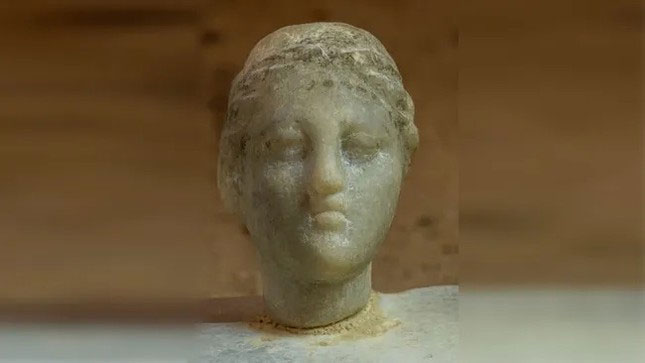Mystery of white stone statue wearing crown believed to be Queen Cleopatra
A small statue of a woman wearing a royal crown may depict Queen Cleopatra VII, an archaeologist says.
A small statue was discovered under a temple wall at the site of an ancient Egyptian city.
The white marble statue depicts a woman wearing a royal crown.

The bust shows a woman wearing a crown, possibly depicting Queen Cleopatra VII. (Photo: Egyptian Ministry of Tourism and Antiquities)
Archaeologists excavating believe the statue may depict Cleopatra VII , the Egyptian queen who was in love with Julius Caesar and Mark Antony.
Cleopatra VII (lived 69–30 BC) was the last ruler of the Ptolemaic dynasty, which began when Ptolemy I Soter, one of Alexander the Great's generals, began ruling ancient Egypt in 305 BC.
However, other archaeologists do not believe that the bust depicts Cleopatra VII, but rather represents a princess or other royal woman. Zahi Hawass, Egypt's former antiquities minister who was not involved in the discovery but has excavated at the site in the past, said he thought the bust dated after Cleopatra's time.
'I examined the bust carefully. It is not Cleopatra at all ,' Hawass said. During the Ptolemaic dynasty, pharaohs were depicted in Egyptian, not Roman, artistic styles. The Roman period in Egypt began in 30 BC after Cleopatra died. Her tomb has never been found.
Archaeologists also unearthed 337 coins, many of which depicted Cleopatra VII, near the busts. They also found other artifacts, such as an oil lamp; a bronze ring dedicated to Hathor, a sky goddess associated with fertility and love; and an amulet engraved with the words "The Justice of Ra has appeared" (Ra is the sun god).
Martinez and her team have been working at the site for more than a decade and have unearthed the remains of temples, tombs, and a vast tunnel beneath one temple. She had previously suggested that Taposiris Magna contained the tomb of Cleopatra VII, but this idea has not been supported by many other archaeologists.
- Discovered the statue of Queen Cleopatra
- Real story of the Egyptian queen Cleopatra
- The burial place of Queen Cleopatra and her lover are about to be revealed?
- The fate of the children of Queen Cleopatra
- Little is known about Cleopatra's queens
- Cleopatra scientist
- Cleopatra - the most powerful woman of the ancient world
- The temple is believed to be the tomb of Cleopatra and her lover
- The way to take care of Cleopatra's skin
- Successful restoration of the 1400-year-old crown of the Empress Queen
- Discover the story of Cleopatra's queen
- The truth about Queen Cleopatra: Both beautiful and fluent in 8 languages
 'Fine laughs' - Scary and painful torture in ancient times
'Fine laughs' - Scary and painful torture in ancient times The sequence of numbers 142857 of the Egyptian pyramids is known as the strangest number in the world - Why?
The sequence of numbers 142857 of the Egyptian pyramids is known as the strangest number in the world - Why? History of the iron
History of the iron What is alum?
What is alum?